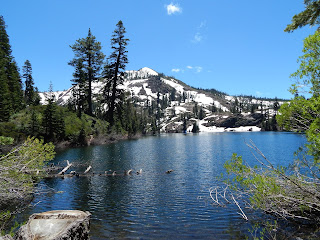We went up to the mountains this last weekend, and I visited some of my favorite foraging spots. I make it a point to get up there every fall so I can harvest Elderberries, gooseberries and whatever other berries I can find. We also look for mushrooms and gather crawdads. I have a favorite area I revisit throughout every year. I pretty much suck at remembering to photograph my every adventure, but over the last few years I have managed to get pictures of a number of my favorites from early spring all the way through harvest. I think this is important because you may be out in the woods yourself at a time of the year when the berries are not ripe but the flowers are blooming. If you recognize plant you can make a note and come back to visit it throughout the summer until you harvest. You will have to re-visit your favorite plants through out the season as they become ripe at different times. We had some serious drought conditions for the last few years, in those years the fruits were few and far between. I love my wild foraged foods but in respect of the scarcity of ripe berries in those dry years I did not take any fruit. I left it for the forest animals who rely on it for survival.
Gooseberry
The large red spined fruits are the gooseberries, the blueish ones are currants.
The gooseberries I find here have some nasty spines protecting the decadent fruits.
Do not let the spines scare you away. Yes they are a little prickly thing, but let that not dissuade you. They make an extremely tasty as a jam or a pie. I use a fork and good garden gloves to harvest. Just hold the plant over your bucket with one hand and use the fork to comb the berries off.
Here the plant is in early spring, when snow is still piled in the shadowy corners of the forest. Note the scalloped leaves, the spines on the stems.
Gooseberries and Currants are practically interchangeable and grow throughout the US. These particular pictures are from the Sierra Nevada's around highway 20 in the Bowman Lake area. I wish I had taken a picture from a few feet back, so you could see that these plants at that location are low lying shrubs. The currants at my dad's house in Oregon are a much taller shrub, with may spines on the stems and leaves but smooth berries. You can find both currants and gooseberries in every part of the US.
https://en.wikipedia.org/wiki/Ribes
Red Flowering Currant
This one was new to me last year, while I was intent upon harvesting those gooseberries and elderberries last fall, I came across these, little blue speckled berries. They have the leaves of the currant, no spines and the berries have a waxy covering. The plants are very tall, especially around wet areas, the leaves are quite large compared to a traditional gooseberry or currant. I knew they were a currant, but until I saw the flower I could not confirm it was the red flowering currant. This last weekend I found them all over,it was a very very wet year. They are now confirmed and I plan to go back through out the year to be there when the harvest comes in.
Manzanita
I know these plants very well, but I have still not been up there when the berries are at their peak. I
In fact I have only found them after they are dried out to a powdery husk. I pulled a few open and tasted them anyhow and I thought they tasted like cookie powder.
These two pictures are of the flowing bush, which has red peeling bark in the summer, bell shaped blowers and round leaves.
https://en.wikipedia.org/wiki/Arctostaphylos
Elderberries
Elderberries are a favorite of mine. I make a syrup or jelly from them. This year I think I will make wine, that is something I have never tried. Elderberries are a powerhouse of nutrition, and are worth the effort it takes to go harvest them. the trees up in the Sierra are bare branches right now, we had a crazy spring so it must be to cold for them yet. The one tree I found down here in the valley was in full bloom in mid May. So that one will have ripe berries 2 months before the ones up in the mountains.
While the berries and flowers are edible, don't consume the stems and branches, they can make you ill. I use a pair of clippers to snip off the berry clusters from the plant. When I am home I use a fork to remove as many berries from the stems as possible. I honestly don't worry to much about the little tiny stems where the berry clusters are, it is all so tiny and nearly impossible to remove every bit of it. I clean them then put them all in a large pot with a small amount of water. Using a potato masher I bring it up to a boil while smashing the berries to remove the juice. use cheese cloth to wring out every bit of juice.
Check out this blog post about the elderberries I have pictured here. She has lots of information including a warning about look alike flowers from the water hemlock which is deadly. Always completely identify your plant before you deem it safe for consumption.
http://www.homesteadandgardens.com/foraging-elderberries-elderberries-find/
* Western Plum, I am still in the identification process.
Since my blog is mainly for my own use, I am including this plant here. I am pretty certain this is the Western plum, Sierra Plum, Klamath Plum basically a widespread wild plum with lots of uses. I found groves of them, all flowers no berries right now. I will be going back up and looking for berries to aid my identification.
https://en.wikipedia.org/wiki/Prunus_subcordata














